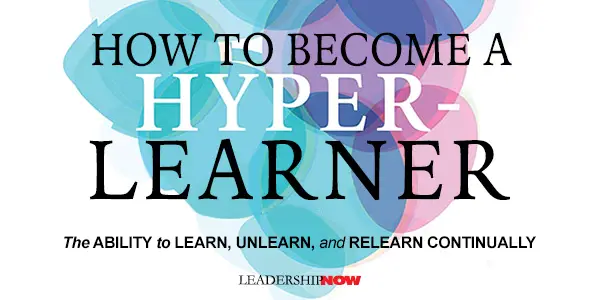 |
 |
02.22.21

How to Become a Hyper-Learner
STAYING relevant in this Digital Age requires that we learn, unlearn, and relearn as a way of being. Ed Hess calls it Hyper-Learning. How well we think, learn, and engage in the human tasks of the future depends on how well we manage and optimize what’s going on with our minds, brains, and bodies. Humankind has always faced these challenges but what is different today is the intensity—the timeframe we have available to learn, unlearn, and relearn. Our egos make us think we know more than we do and gets in the way of hyper-learning. Fear, too, is an inhibitor. If we are to be hyper-learn, we need to listen to understand other perspectives. Too often, we listen to argue or to reinforce our point. To become a Hyper-Learner, we need to become our “Best Self cognitively, behaviorally, and emotionally.” This requires three main steps: Step 1: Achieve Inner Peace Inner peace is important because in this state, you are better able to approach things with an open, nonjudgmental, and fearless mind. We cultivate inner peace by quieting our ego, our mind, and our body, and developing a positive emotional state. With inner peace, you are better able to slow down and “exercise choice in your thinking, emotions, and behaviors.” What you must confront is the question of whether your ego is so loud that it impedes your ability to become a Hyper-Learner. “A Quiet Mind is a calm, silent mind focused on the present moment.” It is not competitive. It is a mind that tries to see the world as it is without judging or the distractions that come from multitasking or ruminating. A Quite Body is one that is at peace. “It is not tense, chronically stressed, anxious, angry, fearful, or experiencing pain.” Most of these issues are mental and deal with how we think. They can be influenced by certain meditation and deep breathing practices. Positive emotions are essential to Hyper-Learning. We can learn to generate positive emotions. “Being kind to others, caring about others, being thankful for what you have, and experiencing simple daily joys all contribute to having a Positive Emotional State.” Step 2: Adopt a Hyper-Learning Mindset Hess has indemnified two lifelong learning mindsets: the Growth Mindset and the NewSmart Mindset. Carol Dweck popularized the Growth Mindset. As opposed to the fixed mindset, the growth mindset is based on the idea that our intelligence is not fixed but that we can learn, improve our skills, and grow. It sees potential. The NewSmart Mindset redefines what “smart” is. Rather than seeing smart as knowledge accumulation and recall, NewSmart views smart and thinking in ways computers can’t— “ways that involve exploration, discovery, imagination, morals, creativity, innovation, and critical thinking when there are lots of unknowns or little data.” Step 3: Behave Like a Hyper-Learner As a Hyper-Learner, your behavior matters. “Behaviors are how you operationalize your values, belief, and purpose.” Great line. Behaviors reflect how you see or define yourself. To change behaviors, you have to change the story you tell about yourself. Behaviors are granular. They are reflected in how you talk, your tone, your physical presence, your volume, how you connect with people, how you listen, how you think, how you manage your emotions, how you ask questions, and how you react. Hess asks us to list what behaviors do we think are necessary to become Hyper-Learners? He provides a list of some like curiosity, humility, social intelligence, empathy, courage, resilience, and trustworthiness. We not only need to be different, but we must learn to work differently. Specifically, we need to humanize the workplace and create an environment that mitigates ego and fear. Humanizing the Workplace means that the desired values and behaviors are woven into the daily way of working—the daily fabric of the organization—through practices that are used by all people every day. Hess emphasizes the importance of emotional connections. And the answer to the question, why do I exist? “People are yearning for more from their work. They want more meaning and richness and to experience more joy. They want higher-quality emotional connections with others. And it’s not just coming from younger generations.” What makes Hyper-Learning practical is its focus on behaviors. He does this through explanation but, more importantly, with a workshop/workbook format that encourages active participation with the text through reflection and journaling. 
Posted by Michael McKinney at 12:01 AM
|
BUILD YOUR KNOWLEDGE
 

How to Do Your Start-Up Right STRAIGHT TALK FOR START-UPS 
Grow Your Leadership Skills NEW AND UPCOMING LEADERSHIP BOOKS 
Leadership Minute BITE-SIZE CONCEPTS YOU CAN CHEW ON 
Classic Leadership Books BOOKS TO READ BEFORE YOU LEAD |